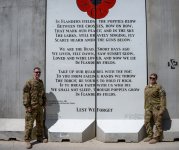- Reaction score
- 4,266
- Points
- 1,260
This, from the Pentagon's info-machine ...
The poppies grow…on Bagram Airfield: famed Canadian poem displayed at BAF
Story by Capt. Keenan Kunst
455th Air Expeditionary Wing
These words, hallowed to many, have had a lasting impact on Canada and a storied history in the nations of the British Commonwealth. They also sit on the Bagram Airfield flightline, towering on a T-wall barrier outside the 455th Expeditionary Aeromedical Evacuation Squadron, punctuated by the image of a single red poppy.
For the past hundred years, the poem “In Flanders Fields,” has honored fallen soldiers and served as a reminder, for many people, to maintain integrity and carry on the legacy of those who have sacrificed for the greater good.
Originally penned by Canadian Army surgeon Lt. Col. John McCrae after the Second Battle of Ypres in 1915, the poem was brought to BAF in 2016, appropriately, by a Canadian.
Capt. Damien Miller, a Royal Canadian Air Force flight and critical care nurse from Trenton, Ontario, recently wrapped up his service with the 455th EAES, with which he deployed as part of a unique service exchange program.
Miller said that despite the relatively small size of the Canadian flight aeromedical evacuation unit, the exchange program allowed him to temporarily relocate to Scott Air Force Base, Il. There, he is fully integrated into the U.S Air Force—including deployment cycles.
However, coming to Bagram and putting his skills into action in a combat zone was not incidental—he sought forward deployment to Afghanistan.
“It was a dream. I think, like most soldiers, you train to do your job overseas in an active area of responsibility, so this was something I was really hoping to do and really pushed to do,” Miller said.
Having finally served at Bagram as a member of the premier aeromedical evacuation unit in Afghanistan, he wanted to leave his mark.
“When we first arrived, we had a meeting with Brig. Gen. Sears and he said, ‘if nothing else, I want you to leave Bagram a better place,’” recounted Miller.
“So, I started thinking and then the squadron asked for us to submit ideas for t-wall paintings and I submitted three designs and all three were picked.”
The other two depict seemingly universal aeromedical themes, but it’s the third one that’s uniquely Canadian. Sitting adjacent to the C-130J Super Hercules hangar, between the shipping containers and metal structures that comprise the airlift and maintenance facilities, is a large concrete slab—known as a t-wall—painted strikingly white and topped with the simple painting of a vivid red poppy. Below the flower is the entire text of McCrae’s “In Flanders Fields.”
McCrae’s words, in French rondeau style, have become a staple of Canadian culture; it’s iconic as part of Remembrance Day ceremonies and an excerpt can even be found on the Canadian ten-dollar note.
“All through public school, every Remembrance Day, you hear that poem. Now that I’m in the military, I go to ceremonies and memorials and they read it. It’s just engrained in our culture,” said Miller.
Both the poem and the poppy grew—literally and figuratively—from the battlefields of World War I. McCrae and his good friend Lt. Alexis Helmer fought with the Canadian Expeditionary Force at the second battle of Ypres in the north Belgian region of Flanders.
In a letter to his mother, McCrae described the horrors of the vicious battle, “We have been in the most bitter of fights…in all that time while I was awake, gunfire and rifle fire never ceased for sixty seconds…and behind it all was the constant background of the sights of the dead.”
Helmer did not survive the battle. According to the widely accepted legend, at his friend’s funeral, or shortly after, McCrae was struck by the quickness with which the scarlet poppies grew on the graves of fallen soldiers. Inspired by the flowers and his late friend, McCrae quickly wrote the now immortal elegy.
“I think his intent of the poem was to talk about the duty people have to carry on despite losses,” said Miller, reflecting on the poem’s accepted meaning.
But, Miller says, it’s since morphed in the modern Canadian zeitgeist.
“It’s so closely associated with remembrance of the veterans now. I think people really have to think about it to see the actual, Lt. Col. McCrae intent; but any Canadian you’d ask, would say it’s for remembrance.”
Miller says it’s also evolved for him personally, particularly after joining the military.
“When you’re in school, you hear it every Remembrance Day and you know it by rote. But once you join the military, especially after deploying, it takes on a new meaning, because you know people who have lost their lives or you know those who are drastically changed because of their experiences.”
Canadians, and citizens of other Commonwealth Nations, may have the poem etched in their minds, yet many Americans may be unfamiliar with it. Any American could contemplate the poem and draw their own conclusions, but Miller has his own, personal thoughts on what American service members can take from McCrae’s verses.
“The original intent of knowing your duty and knowing you’re here to fight for peace and, despite the fact that people are falling, it’s your job to pick up that torch and carry on—I think that’s motivational.”


